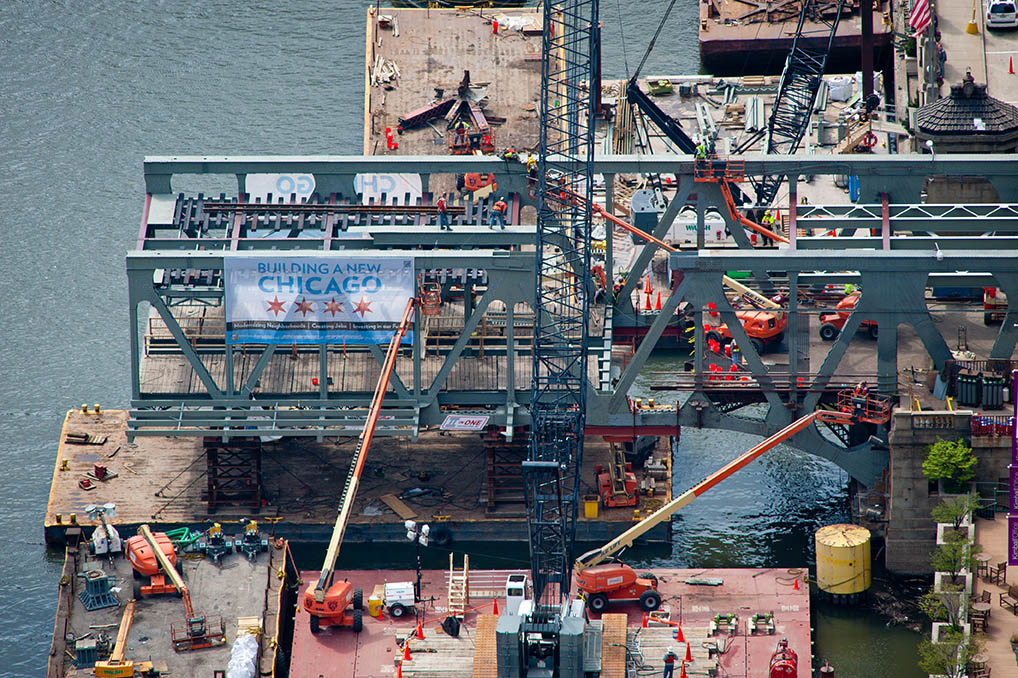Infrastructure, Transportation and City Services

Chicago’s rise has been fueled by its place at the center of the nation’s transportation system, from its role as a nexus for highways and railways due to its proximity to Lake Michigan and the Mississippi River. Mayor Emanuel believes that the city’s future depends on modern infrastructure and has invested accordingly through initiatives like Building a New Chicago, Building on Burnham, 311 Modernization and a historic investment in the Chicago Transit Authority. Over the last eight years, the Emanuel administration has sought and secured more than $4.6 billion in federal funding for Chicago transit and has directed $35 billion to be spent on construction and renovation for schools, parks, transit, roads, bridges, and water and sewer main replacement, creating an estimated 150,000 jobs.
-
Launched in 2012, Building a New Chicago is an $8 billion infrastructure program and one of the largest investments in infrastructure in the city’s history. The program has touched nearly every aspect of the city’s infrastructure network and is supporting more than 30,000 jobs.
-
During his two terms in office, Mayor Emanuel expanded Chicago’s park assets through his ambitious Building on Burnham Plan. Working with the Chicago Park District, Mayor Emanuel met—and exceeded—targets to increase residents’ access to green spaces and waterfronts. Today, nearly every Chicago resident lives within a 10-minute walk of a park or open space.
-
The Chicago Department of Transportation, the Department of Water Management, private contractors, and utilities will have resurfaced more than 2,165 miles of streets and alleys during Mayor Emanuel’s tenure. Nearly 600 miles of old water mains have been replaced and more than 450 miles of sewer mains have been replaced or lined since 2011.
-
Mayor Emanuel has worked to improve the city’s bicycling infrastructure to foster the quality of life that will attract businesses and families to Chicago. The city now offers more than 210 miles of on-street protected, buffered and traditional bike lines, plus many miles of off-street paths and more than 15,000 bike racks. The Divvy bikeshare system is benefitting from a $50 million modernization and expansion resulting in approximately 16,500 bikes across 800 stations. The system will expand to all 50 wards by 2021.
-
Through the Chicago Smart Lighting Program, the Chicago Department of Transportation has replaced 100,000 street lamps and is on track to complete the replacement of 270,000 of Chicago’s outdated High-Pressure Sodium lamps with modern, longer-lasting LED fixtures over the next three years. The program is expected to save taxpayers $100 million over the next decade.
-
The Chicago Riverwalk has transformed downtown’s waterfront into a vibrant, pedestrian-friendly cultural destination for more than 1.5 million visitors annually. The now 1.25-mile promenade is one of the city’s most popular destinations for art, music, recreation and dining and generates $1.2 million in city revenues annually.
-
The entire 18-mile Lakefront Trail was successfully separated in 2018, offering two distinct paths for cyclists and pedestrians, increasing the safety of the 100,000 people who use the trail daily during summer weekends.
-
Since 2011, the Chicago Transit Authority has announced $8 billion in transit improvements amounting to one of the largest in the system’s history. Among the improvements are new buses and rail cars, new and renovated stations, plus technologies to improve rider experience like bus and train tracker screens, high definition security cameras, and 4G wireless in all CTA subways.
-
Since 2011, more than $11 billion in airfield, passenger terminal, and infrastructure investments have been secured for Chicago’s airports. The O’Hare 21 program will deliver the biggest terminal expansion in ORD history. Over the next decade the $8.5 billion initiative will usher in capacity-building and connectivity-enhancing projects within and around the terminals to streamline travel and upgrade the passenger experience.
